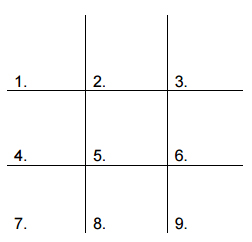
This is the second article of a six-part series on boosting classroom participation. Last week, we heard about overcoming both teacher and student anxiety in the EFL classroom. In this article, Zarina discusses different learning styles and how to support those students who may not be as receptive to our usual forms of teaching.
“There are no difficult students – just students who don’t want to do it your way.” Revell, J. and Norman, S. (1999): p.65.
In the previous article in this series, I looked at the presence of anxiety in the EFL classroom, and the various techniques you can employ in order to reduce it. I explored how you can stage competitions and games to help students to overcome fears of making mistakes. These kinds of activities are also beneficial for the way that they often provide for more than one learning style, and so engage a diverse range of students.
First let’s start by thinking about the many different tasks involved in playing a game, whether it’s simple or complex. There is often something visual to look at, there will be instructions to listen to, and usually there is something to do, which could involve moving around the room, or moving things around (for example, a counter on a board). If we look at this in terms of learning styles we can categorise the same things into: Visual, Auditory or Kinaesthetic learning styles. Some like to refer to these styles as VAK, others add ‘R’ for Reading / Writing and refer to it as VARK. If you are interested in finding out about you or your students’ preferred learning styles are, try this online questionnaire.
Of course, we can’t simply put individuals into such narrowly defined categories, and it’s impossible to teach to suit each and every student’s personal learning style (even if you knew what it was). More pragmatically, however, I think we can provide an array of activities to engage a range of learning styles.
Who is being difficult – the learner, or the teacher?
Whether you are a believer in the theory that we have preferred styles of learning or not, you have to admit that being exposed to only one style (for example, concentrating solely on an audio input, such as a lecture) can be exhausting, both for the teacher and the learner. It seems quite feasible that in such a situation, rather than the learner being ‘difficult’, they simply ‘don’t want to do it your way’.
The more years we teach, there is a danger that we tend to fall back on activities and methodologies that we believe work well or feel safe with. There is a possibility that our lessons get a bit ‘samey’, with the same kind of pace, the same type of activities, the same students taking an interest, and the same students not really engaging in the lesson. One reason this can happen is that we will often end up teaching according to our preferred style, which may be strongly influenced by our own learning styles. (Note I say styles, because the likelihood is that we are a blend of them, with certain preferred tendencies; we can never completely have only one learning style.) Moving out of our comfort zone takes more effort and energy. So how about trying something slightly different?
Things to try
- Take a photocopiable text that has clear paragraphs and subheadings. Make copies for several groups of students (one per group) and cut up the paragraphs. Depending on the level of your students, you could cut up the subheadings as well. Students have to figure out the gist and topics of each paragraph to match it to a subheading, before putting the paragraphs in order.By taking this reading activity ‘onto the table,’ it instantly becomes kinaesthetic. It encourages more discussion, collaboration and cooperation, and a spatial/visual element comes into play, as the students move the paragraphs into the correct order. This kind of activity uses all three of the learning styles. By giving points for the 1st, 2nd and 3rd quickest teams, you have a competition that adds more impetus and incentive to the activity.
- Using sticky labels, you can review vocabulary and definitions (either pictorial or written); verbs and prepositions; collocations; present and past forms of a verb; or two halves of an idiom.
a. Write out enough stickers so there is one for each student and stick it on each of their backs. The stickers need to be written in pairs, so for example, you need to have a word on one, and its definition on the other. If you have an odd number of students, consider joining in yourself or make one a group of three (for example, water – bottle – bank, where water collocates with bottle, and bottle collocates with bank.)
b. The idea is that each person finds their partner. Students must read each other’s cards out loud. Thus reading, speaking and listening occur – using auditory, reading and kinaesthetic learning styles simultaneously. Students often help one another by reminding each other of the meaning of their own card or answering queries about their sticker. Because by the end, with help if necessary, everyone has found their partner(s), you can use this as a review exercise that randomly mixes the class. You can form new groups, or use it as a lead-in to an extensive reading, writing, listening or speaking activity. NOTE: Be prepared for some noise, but good noise!
- If you have more serious students who you think may be averse to game-like activities, try this one.
a. Set a piece of writing work and collect it in to mark, as you normally would.
b. Correct it using a correction code, rather than making the corrections for them. By correction code I mean writing: sp – indicates a spelling error; vt – indicates the wrong verb tense but correct verb; sv – the subject and verb of the sentence don’t agree, etc.
c. Now make a list of nine sentences with mistakes that you think the whole class will benefit from discussing. Make sure that you only use one sentence from one student’s work, i.e. sentences from nine different students.
d. Place students into two groups. Provide a handout with the list of nine sentences that you noted, with mistakes. Give the students time to mull over the sentences and to try and spot the errors. It is important that each sentence contains common mistakes that everyone can benefit from seeing, but also not too many mistakes to have to think about – so you may want to change the sentences slightly from how they were originally written.
e. After they’ve had enough time, draw up noughts and crosses lines; number each box 1-9; make one team noughts (o) and the other crosses (x)

f. Students have to try and get a straight line of either noughts or crosses, depending on which team they are in, while trying to block the opposing team. The numbers correspond to the sentences on the handout. They have to strategically choose a sentence and try to correct it. If they don’t manage to do so, the opposing team gets a bonus point if they can successfully correct it.
g. Give their actual marked written work back (with your correction code) at the end of the game. I guarantee you will have a group of earnestly competitive students who are suddenly interested in written corrections!
Look out for Part Four in this series, next week. I’ll be exploring how you can experiment with different questioning techniques to get more out of your students.
References
Fleming ND (2001) Teaching and Learning Styles: VARK Strategies. Honolulu Community College.
Revell, J. and Norman, S. (1999) Handing Over: NLP-based Activities for Language Learning, Saffire: p.65.
This article was first published in the August 2014 issue of Teaching Adults. To find out more about the newsletter and to sign up, click here.


Some nice ideas and activities which are transferable to the young learner classroom. I have used crossword games before on the whiteboard to review grammar and vocabulary which has emerged during lessons. Highly recommended.